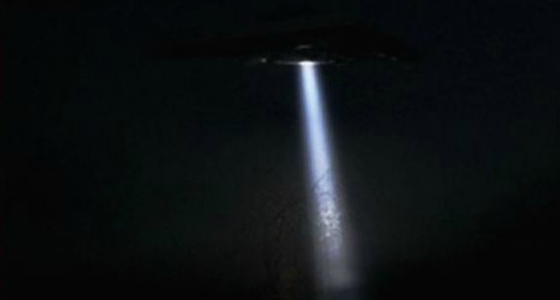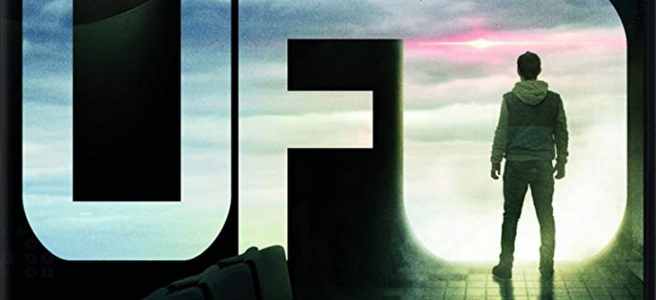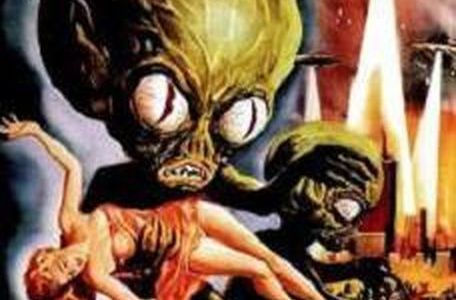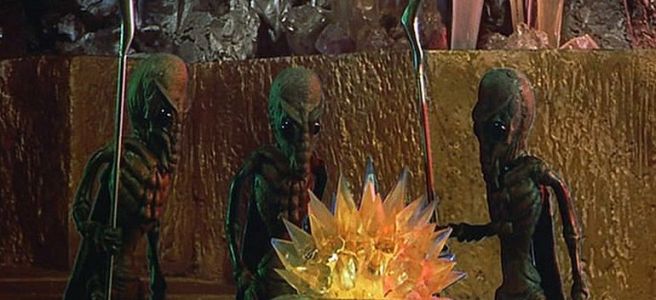I’ve noticed recently how those sincerely interested in the UFO mystery can at the same time dismiss the idea that the phenomenon might possess a more general import. Here and elsewhere I’ve read comments such as, “the UFO culture is now purely entertainment,” “the number of people who actively engage with the UFO topic on a frequent and regular basis (go beyond merely occasionally watching a video clip, listening to a sound bite, or scanning an article) represents a small percentage of the US population,” and that the “real UFO conspiracy [is] why the UFOs have become a joke and such an embarrassing subject in ‘serious’ conversation,” all in stark contrast to the unabashed and breathless enthusiasm of those fascinated by the idea of Disclosure (that at least one of the world’s governments has been in contact with extraterrestrials (ETs) for decades and has been gifted or back-engineered their technology).
“The UFO topic” that that “small percentage” of the population engages with is approximated by, for example, recent stories concerning U.S. Navy encounters with apparently anomalous aeroforms and History’s latest series Project Blue Book and Unidentified: Inside America’s UFO Investigation. As has been the case since Donald Keyhoe wrote his books, in this arena the UFO is invariably imagined to be either an extraterrestrial spaceship or maybe a domestic or foreign aeronautical breakthrough, even for those not unacquainted with Jacques Vallée’s Magonians, John Keel’s ultraterrestrials, or even Mac Tonnies’ crypoterrestrials, or more recent speculations concerning other dimensions and times. The demographic represented by this “small percentage” is imaginably very slight (though one does wonder just what empirical research would in fact show).
On the other hand, since 1947, consistently roughly half the population in North America and Europe believe “flying saucers are real” (however seriously), and, over the same time, the UFO and the ufonauts have invaded and colonized popular culture, so that the UFO as a cultural phenomenon now has a higher brand recognition than, say, Odysseus and Ulysses. It is precisely this liminal ubiquity—being both everywhere but hardly at the centre of attention—that empowers the UFO and ET to express something of, and thereby illuminate, if not overtly influence, the culture at large.
The UFO-as-sign (as a vehicle of meaning) functions both factually and fictionally, regardless of whatever reality the UFO might ultimately turn out to possess. As something taken as real, it has clearly reflected the anxieties of the times. Jung, as is well-known, argued the flying saucer functioned as a compensatory mechanism for the anxieties provoked by the Cold War. On one hand, its circular, mandala shape symbolized the unity absent from a sundered world, while, on another, its seeming a spaceship from a technically-advanced society made it a deus ex machina, an otherworldy, salvific intervention into what seemed a perilous, humanly insoluble crisis. His insight was confirmed by the pacifist messages delivered by the Space Brothers of Adamski and the other Contactees of the 1950s. Decades later, with advances in reproductive technologies, such as the Human Genome Project, the potential for human cloning, and in vitro fertilization, little wonder the hypnotically-induced fantasies of women who believed they’d been abducted by aliens should express the anxieties proper to their time and gender, or that abductees in general sometimes claimed they were shown images of global, often ecological, catastrophe by their abductors just at the time ecological consciousness was dawning toward the glaring near-noon zenith it has reached today.
Given the spontaneous significance attributed to “the visionary rumour” of the UFO and ET contact, it should come as little surprise, likewise, that the creative imagination should find in it an endlessly fecund figurative resonance. Cinema (as Robbie Graham would likely agree) and to a lesser extent television perhaps more than any other media have made the most of this material, as, for example, a metaphor for race (in the films The Brother from Another Planet, Alien Nation, or District 9), global warming (The Arrival), mass extinction (The X-Files episode “Fearful Symmetry”), and the insatiable rapaciousness of capitalism (Independence Day).
For example, the remake of the classic The Day the Earth Stood Still twists together the anxious and the hopeful. On the one hand, the alien Klaatu is sent to earth to oversee the destruction of every trace of humankind and its civilization that are rendering the planet uninhabitable for complex life; however, nonhuman, animal organisms are taken up by spherical craft that serve as arks to preserve them from the cleansing process so they may be reintroduced after its completion. Fortunately, Klaatu is persuaded to avert the eradication of human life and, instead, brings to a standstill the technology whose destructive effects brought about the crisis. (The credits roll too soon, though: the results of a global cessation of mechanical technology would doubtless prove catastrophic, resulting in, among other things, mass starvation, with the paralysis of transportation, food processing, and agriculture, a far more cruel, drawn-out process of eradication than the one initially proposed by Klaatu’s civilization!).
The ecological focus and critique of “development” are clear; the imagined solutions, however, are, ironically, hopeless: humankind itself is incapable of collective action to avert ecological destruction; it, therefore, stands in need of an external, overpowering intervention, whose only proposed solutions are the elimination of homo sapiens (in line with the biocentric ideology of EarthFirst! or the more recent philosophy of anti-natalism) or of the technologies of the so-called developed world. The film’s solutions to our very real problem are less acceptable than the premise of the film as a whole, framing the urgent crisis at its heart as insoluble, inspiring either a resigned fatalism, or, more charitably, a reflective search for alternatives to the unacceptable dilemma posed by the film itself.
The cinematic versions of 2001: A Space Odyssey and 2010: The Year We Make Contact develop the theme of the deus ex machina, but along a slightly different trajectory. Both are stories about the guided development (mental or spiritual if not morphological) of anthropomorphic life, from the proto-, to the human, to the meta- or hyperhuman. The genius for tool-use, from a bone-as-club to interplanetary spacecraft and AI, is sparked in the genus Homo by an extraterrestrial agent, represented by an enigmatic, black monolith. One such monolith discovered on the moon, prompts an exploratory expedition to Jupiter, where astronaut Dave Bowman is “evolved” to a superhuman being. In the sequel, a subsequent expedition to discover what happened to the first sets in motion the transformation of Jupiter and its moons into a miniature solar system, a supplementary space for human habitation and resource extraction intended to ease tensions on an overcrowded earth that narrowly escapes nuclear war.
In this fictional universe, the Promethean spirit of technological ingenuity (and power) is posited as a kind of divine spark. Striking it in the protohuman creates a being in the image of the mysterious makers of the black monolith, who guide and shape humankind to ever higher technological achievement and biological/spiritual development ultimately, one might suppose, with the goal of having us attaining their level. It is difficult not to detect a value system underwriting this narrative. Ironically, technological sophistication (e.g., the capacity to invent and build weapons of mass destruction) is not accompanied by a moral or social sense equal to governing the species-suicidal potential of our technical know-how, so, otherworldly intervention is needed. Two problems present themselves. First, if technological savvy is not accompanied by the collective intelligence necessary to control it, then how did the makers of the black monoliths survive this impasse? Secondly, the solution they provide is stop-gap: the essential problem of infinite growth in a finite environment that characterizes the economic system of capitalism, whose advent underwrote the Industrial Revolution, is only temporarily solved by adding more Lebensraum and exploitable resources. The solution to earth’s problems in 2010 seem in hindsight a metaphor for the planned exploration and resource extraction within the solar system and the asteroid belt, the setting for the television series The Expanse and an important assumption in Aaron Bastani’s manifesto, Fully Automated Luxury Communism. In this case, the imagined solutions to our real problems amount to either faith (indistinguishable from the Christian’s that all works out in God’s plan for humankind) and/or more of the (doomed) same.
In both fact and fiction, then, the UFO and ET appear within the horizon of, and expressing, the existential crises of our time, solving by means of their superiour technology the dire problems the development and deployment of our own have brought to pass. The human being, moreover, plays a singular, special role: the ufonauts spontaneously recognize homo sapiens as their earthly counterpart among all the other species of life on earth, because of a shared Promethean character, due either to their having implanted it in us or to its being natural to intelligent life: intelligence implies tool-use, which is merely nascent technology. In the real world, even in arguments offered for the Search for Extraterrestrial Intelligence (SETI), the mere fact of an existing, vastly more advanced technological civilization is evidence that ours can navigate the impasse that threatens to destroy our own, either by following their example or, as in the cinematic examples above, through their direct intervention.
It is precisely, however, the way ET mirrors ourselves, is a projection of ourselves, that gives the game away and reveals an important, if not the primary way, the UFO mythology works in society at large. As I have argued repeatedly and at length here and elsewhere, positing anthropomorphic intelligence, tool-use and technology as natural (universal) propensities to life-as-such is to treat as universal one very geographically and historically local and contingent social formation, namely that of the so-called “First” or “developed world”. This megalomaniacal projection of the aleatoric trajectory of one portion of the population of one form of life on earth finds a mythical legitimation in, for example, the book of Genesis wherein God creates Man in His own image and a science-fictional one in the universe of 2001 and 2010 wherein an extraterrestrial agent plays both a Promethean and parental role. In either case the destiny of humankind is imagined to be fated, necessary, and, divinely or otherwise, ordained.
The solutions to humanity’s problems proposed in both The Day the Earth Stood Still and 2010 drive this point home all the harder. Either humanity and all traces of it need disappear, or its technology must cease operating, or it must stay the course. None of these are workable. This apparent impasse however results from the assumed inalterability of the status quo: the unspoken (because unspeakable) solution is social change. As Fredric Jameson put it so well: “It’s easier to imagine the end of the world than the end of capitalism.” In its affirmation of existing society, in both its factual and fictive forms the UFO-as-a-sign functions ideologically, maintaining the status quo by occluding the possibility of imagining that things might be otherwise.
Ironically, cinematic pop culture performed this ideology critique already in 1988, in John Carpenter’s They Live!. In this film, the earth has already been colonized by a malevolent alien race that maintains its power by means of a technology that creates an illusory world, that of North America in the late twentieth century. The protagonist has his eyes opened to this reality when he dons a pair of sun glasses with the power to reveal the subliminal messages of advertising and entertainment, etc. that keep humanity in its virtual chains. The deliciousness of this plot is double: the capitalist ruling class is shown “in reality” to be a repulsive, cowardly alien race, thereby inverting the motif of the ET-as-benevolent-saviour in Jung, the Contactees, and 2001 and 2010.
[Interested parties are invited to hear philosopher Slavoj Žižek present his reading of They Live! as ideology critique in his own, inimitable manner!]
Because the UFO mythology is both ubiquitous and liminal, the actual percentage of the population that might admit to consuming either documentary or fictional UFO material is beside the point. The myth is “in the air”, vaguely familiar to everyone, but hardly considered by anyone, a status that enables it to function just below and at the edges of conscious thought. When it does intrude on consciousness, as either fact or fiction, the UFO-as-sign mirrors back to us after its fashion not an Otherness but an insidious Identity. It signifies in this way through no fault of its own; a mirror can only reflect what is in front of it, and, in this case, that is the world capitalism and technology, industrial or otherwise, have made. That the UFO should appear in this way, enlisted in the maintenance of an ecocidal order, is a crime against humanity in particular and life in general, that something that should be out of this world and therefore throwing that world into relief, estranging it through difference, revealing it in all its contingency and alterability, becomes something pitifully, pathetically human, all-too-human.




 its plotting and its probing the relation between language and consciousness. Its first virtue is how the aliens resemble octopi or squid more than human beings.
its plotting and its probing the relation between language and consciousness. Its first virtue is how the aliens resemble octopi or squid more than human beings.  Even when this disguise is finally ripped off in the movie’s climax, the audience sees only an impersonal black form, as featureless as the liquid form is amorphous. By refusing to actually depict an alien, it employs a visual metaphor that is all the richer for its being nonliteral.
Even when this disguise is finally ripped off in the movie’s climax, the audience sees only an impersonal black form, as featureless as the liquid form is amorphous. By refusing to actually depict an alien, it employs a visual metaphor that is all the richer for its being nonliteral. The figure of the Mothman not only appears as a dark, indistinct, red-eyed menacing silhouette, but pareidolically as a mark on a car’s radiator grille, tree bark, and, most wittily, in a brainscan image.
The figure of the Mothman not only appears as a dark, indistinct, red-eyed menacing silhouette, but pareidolically as a mark on a car’s radiator grille, tree bark, and, most wittily, in a brainscan image. These latter imaginings share the strengths of those in Under the Skin and The Mothman Prophecies in being more suggestive than literal. As hybrid clones, the alien is as much a monstrous DNA as nonhuman being. The shapeshifting variety (however anthropocentric) wears its protean, unclassifiable Otherness on its sleeve, as it were. And the black oil combines alien-as-infection body horror, the fluid identity of the shapeshifter, and a metaphorical resemblance to petroleum ,all in a single, tour de force image.
These latter imaginings share the strengths of those in Under the Skin and The Mothman Prophecies in being more suggestive than literal. As hybrid clones, the alien is as much a monstrous DNA as nonhuman being. The shapeshifting variety (however anthropocentric) wears its protean, unclassifiable Otherness on its sleeve, as it were. And the black oil combines alien-as-infection body horror, the fluid identity of the shapeshifter, and a metaphorical resemblance to petroleum ,all in a single, tour de force image.



